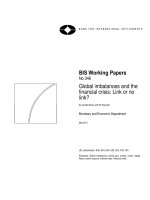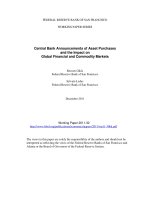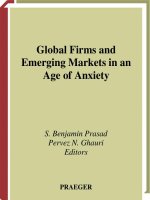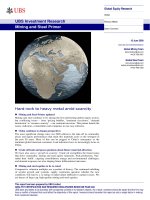Global marketing and rd
Bạn đang xem bản rút gọn của tài liệu. Xem và tải ngay bản đầy đủ của tài liệu tại đây (209.15 KB, 52 trang )
International Business 7e
by Charles W.L. Hill
McGraw-Hill/Irwin Copyright © 2009 by The McGraw-Hill Companies, Inc. All rights reserved.
Chapter 17
Global Marketing and R&D
17-3
Introduction
The marketing mix (the choices the firm offers to its
targeted market) is comprised of:
product attributes
distribution strategy
communication strategy
pricing strategy
17-4
The Globalization Of Markets And Brands
Theodore Levitt argued that world markets were
becoming increasingly similar making it unnecessary to
localize the marketing mix
Levitt’s theory has become a lightening rod in the debate
about globalization
The current consensus is that while the world is moving
towards global markets, cultural and economic differences
among nations limit any trend toward global consumer
tastes and preferences
In addition, trade barriers and differences in product and
technical standards also limit a firm's ability to sell a
standardized product to a global market
17-5
Market Segmentation
Market segmentation involves identifying distinct groups
of consumers whose purchasing behavior differs from
others in important ways
Markets can be segmented by:
geography
demography
socio-cultural factors
psychological factors
17-6
Market Segmentation
Firms need to be aware of two key market segmentation
issues:
1. the differences between countries in the structure of
market segments
2. the existence of segments that transcend national
borders
When segments transcend national borders, a global
strategy is possible
17-7
Classroom Performance System
Which of the following is not an element in the marketing
mix?
a) product attributes
b) communication strategy
c) distribution strategy
d) production strategy
17-8
Product Attributes
A product is like a bundle of attributes
Products sell well when their attributes match consumer
needs
If consumer needs were the same everywhere, a firm
could sell the same product worldwide
But, consumer needs vary from country to country
depending on culture and the level of economic
development
17-9
Cultural Differences
Countries differ along a range of cultural dimensions
including:
tradition
social structure
language
religion
education
While there is some cultural convergence among nations,
Levitt’s vision of global markets is still a long way off
17-10
Economic Development
A country’s level of economic development has important
marketing implications
Consumers in highly developed countries tend to
demand a lot of extra performance attributes
Consumers in less developed nations tend to prefer more
basic products
17-11
Product And Technical Standards
Levitt’s notion of global markets does not allow for the
national differences in product and technological standards
that force firms to customize the marketing mix
17-12
Distribution Strategy
A firm’s distribution strategy (the means it chooses for
delivering the product to the consumer) is a critical element
of the marketing mix
How a product is delivered depends on the firm’s market
entry strategy
Firms that manufacturer the product locally can sell
directly to the consumer, to the retailer, or to the wholesaler
Firms that manufacture outside the country have the
same options plus the option of selling to an import agent
17-13
Distribution Strategy
Figure 17.1: A Typical Distribution System
17-14
Differences Between Countries
There are four main differences in distribution systems:
1. retail concentration
2. channel length
3. channel exclusivity
4. channel quality
17-15
Differences Between Countries
1. Retail Concentration
In a concentrated retail system, a few retailers supply
most of the market
In a fragmented retail system there are many retailers, no
one of which has a major share of the market
Developed countries tend to have greater retail
concentration, while developing countries are more
fragmented
17-16
Differences Between Countries
2. Channel Length
Channel length refers to the number of intermediaries
between the producer and the consumer
When the producer sells directly to the consumer, the
channel is very short
When the producer sells through an import agent, a
wholesaler, and a retailer, a long channel exists
Countries with fragmented retail systems tend to have
longer channels, while countries with concentrated systems
have shorter channels
The Internet is helping to shorten channel length as is the
emergence of large stores like Wal-Mart and Tesco
17-17
Differences Between Countries
3. Channel Exclusivity
An exclusive distribution channel is one that is difficult for
outsiders to access
Japan's system is an example of a very exclusive system
17-18
Differences Between Countries
4. Channel Quality
Channel quality refers to the expertise, competencies,
and skills of established retailers in a nation, and their
ability to sell and support the products of international
businesses
The quality of retailers is good in most developed
countries, but is variable at best in emerging markets and
less developed countries
Firms may find that they have to devote considerable
resources to upgrading channel quality
17-19
Choosing A Distribution Strategy
The choice of distribution strategy determines which
channel the firm will use to reach potential consumers
The optimal strategy depends on the relative costs and
benefits of each alternative
Since each intermediary in a channel adds its own
markup to the products, there is generally a critical link
between channel length and the firm's profit margin
So, when price is important, a shorter channel is better
A long channel can be beneficial because it economizes
on selling costs when the retail sector is very fragmented,
and can offer access to exclusive channels
17-20
Classroom Performance System
The main differences between distribution systems include
all of the following except
a) retail concentration
b) product attributes
c) channel length
d) channel exclusivity
17-21
Communication Strategy
Communicating product attributes to prospective
customers is a critical element in the marketing mix
How a firm communicates with customers depends partly
on the choice of channel
Communication channels available to a firm include
direct selling
sales promotion
direct marketing
advertising
17-22
Barriers To International Communication
International communication occurs whenever a firm
uses a marketing message to sell its products in another
country
The effectiveness of a firm's international communication
can be jeopardized by:
1. cultural barriers
2. source and country of origin effects
3. noise levels
17-23
Barriers To International Communication
1. Cultural Barriers – it can be difficult to communicate
messages across cultures
A message that means one thing in one country may
mean something quite different in another
To overcome cultural barriers, firms need to develop
cross-cultural literacy, and use local input when developing
marketing messages
17-24
Barriers To International Communication
2. Source and Country of Origin Effects
Source effects occur when the receiver of the message
evaluates the message on the basis of status or image of
the sender
Firms can counter negative source effects by
deemphasizing their foreign origins
Country of origin effects refer to the extent to which the
place of manufacturing influences product evaluations
17-25
Barriers to International Communication
3. Noise Levels
Noise refers to the amount of other messages competing
for a potential consumer’s attention
In highly developed countries, noise is very high
In developing countries, noise levels tend to be lower









